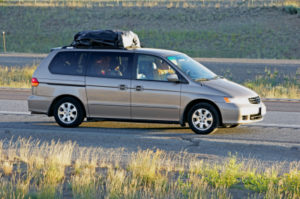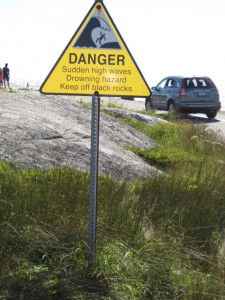Change is good, right?
Every CEO I have met tells me they like change. They are enthusiastic and optimistic about the changes they have launched in their organization. Ironically, it can be this optimism and enthusiasm that increases the risk your change efforts will fail to achieve their desired result.
One characteristic of a skilled change leader is energy and perseverance. The challenge for every leader is determining the amount of energy and perseverance needed for the changes Their organization needs to make. I was reminded of this challenge this past summer when I drove (for the first time) the 2400 kilometers from Winnipeg, Manitoba to Victoria, British Columbia.
 Those who know me may be thinking—wait a minute Dawn-Marie, you have driven to Victoria many times. It’s true. My husband and I have been making that drive for over two decades. But this past summer was different. This summer I did the driving. Previously, my husband did all the driving. I enjoyed the trip as the passenger and self-appointed navigator. But my trip was a totally different experience as the driver versus the passenger.
Those who know me may be thinking—wait a minute Dawn-Marie, you have driven to Victoria many times. It’s true. My husband and I have been making that drive for over two decades. But this past summer was different. This summer I did the driving. Previously, my husband did all the driving. I enjoyed the trip as the passenger and self-appointed navigator. But my trip was a totally different experience as the driver versus the passenger.
The Energy of Organizational Change
It’s similar with organizational change. As an executive leader, you are often the person launching change in your organization. Making the strategic decisions, deciding what changes are needed. Once decided, it’s usually the executive leader(s) who decide when a change should begin, and (more importantly) when it is expected to be completed. It’s here that your position, optimism, and enthusiasm for the change event can set your employees and thus your organization up for failure. That’s because each one raises the risk of an energy crisis.
Making the decision to launch a change requires a different type and level of energy than what’s needed to adopt the new activities, and behaviours needed to accomplish the intended outcome.
To avoid an energy crisis, leaders need to ask three questions:
- What level of discomfort do I believe will be required to move from its current state to the new state?
- How does my belief differ from the people who will be required to make the greatest amount of change?
- What will I need to do to reduce and support the discomfort needed for change?
The answer to these questions, and thus the amount of energy needed, depends on two things. First, the impact of the change for the people affected — that is the difference between the current state and the desired outcome. Second, it depends on your organization’s current change capacity. Change capacity is your organization’s ability to move through any individual change, while maintaining daily operation, and supporting your ability to handle future changes.
Adoption Requires More Energy Than Making the Decision to Change
One reason is because they underestimate the difficulty and impact of the change for the people affected (the change-recipients).
A change that may appear low risk and easy at the executive level may, at the frontline level, be complex and perceived as riskier. Results of an online test taken by over 10,000 leaders and employees found each group’s view of risk was different. The survey found 66% of CEOs were willing to take a risk when it came to change versus 24% of employees. This is not surprising when you consider that most of the work of any change initiative falls to the mid-level managers and the frontline employees of the organization.
Think about the adoption of that new IT system, process redesign, the recent merger, or reorganization. These or any other changes look and feel different to the managers and other employees than they do for the executive. It is the employees who are expected to support, and adopt the new activities, behaviours, roles and responsibilities, reporting relationships, and tasks into their daily operation.
Adoption requires more energy than making the decision to change.
Delegating the work of change and moving through the process is very different.
As the driver, there were many aspects of the drive that felt different. One of the most significant was driving through the mountain passes. As a passenger I had always enjoyed the winding roads, turns, and inclines of Crow’s Nest and Roger’s Pass. I took in the view, relaxed and let the road unfold.
As the driver I barely notice the view. I was too afraid to take my eyes of the road for one minute. And those turns and inclines that hadn’t seemed so bad as a passenger, got a whole lot sharper and steeper. I often found myself exhausted. I constantly tracked my progress to know how much farther.

We needed to make more frequent stops. At one point, when I had reached my driving capacity for the day, I said to my husband, “I don’t know how you have done this drive all these years. It’s harder than it looks”.
It’s similar when you initiate change in your organization. The energy needed to navigate through the Whitespace is greater than that needed for the change event. The Whitespace is the space between where people are when the decision to change is made and where they need to be to adopt the new state.
Your optimism, enthusiasm, and full commitment to any change you launch in your organization is absolutely necessary, but it’s not sufficient for success. These three steps will help ensure you and your employees have the energy to enable healthy organizational change.
- Make time to engage your leaders, managers, and employees in conversations to explore, understand and account for the Whitespace. What does the change look like from their perspective? What is their perception of risk? What can be done to lower the risk?
- Assess the organization’s and the people’s current capacity for change. Where does this current change event fit with other changes and initiatives in the organization? How much time, realistically, will be needed to ensure the new activities can be adopted and not just implemented?
- Ensure your leaders and managers are prepared for the change event before other employees. What new skills will they need to lead the change process? The skills needed for daily operation are not the same skills needed for leading change.
In the next blog post I will explore how you can maintain your energy level so you can go the distance and achieve your intended outcome.
Dr. Dawn-Marie Turner
Turner Change Management – Think Transition: Turn change from a liability to an asset

The good, the bad, the ugly. Your employees remember it all

Help! I am communicating, but my employees aren’t listening: three ways to use email to help your employees buy-in to change.





Leave a Reply
Want to join the discussion?Feel free to contribute!